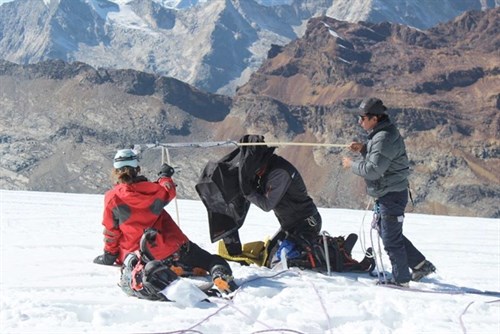Mountain Research: Ecological Indicators & Untapped Data
Alpine Mountain Ranges Offer Opportunities for Important Research
by Dunham Gooding
President, American Alpine Institute
Over the years, the American Alpine Institute has teamed up with a variety of academic and scientific organizations to support a important research projects in mountain environments. The Institute’s role is to provide technical training to scientists, research assistants, student participants, and volunteers, and to recruit volunteers to assist with data collection and, secondarily, enjoying the opportunities to climb and explore.
High mountain regions – especially those with glaciers – are a treasure trove of important data that can inform upon the functioning and health alpine ecosystems and their individual components. Because high mountain and alpine environments are quite fragile, measurable indicators of change are commonly generated more rapidly than in lower altitude ecosystems. As a result, the data collected there can more quickly inform upon the evolution of both chronic and acute impacts than data in other ecosystems can.
Glaciers are great collectors of data. Surface deposits do not go away, and they can be measured at any time for identification of the matter that composes them including:
- living organisms – microbiomes fed by nutrients in dust;
- black carbon, formed through the incomplete combustion of fossil fuels, biofuel, and biomass – caused both by human activity and such things as naturally occurring vegetation fires;
- heavy metals from open pit mining with a several hundred-mile radius.

Measuring light reflecting off a glacier surface with a spectrometer as a way of determining the amount of dust that has accumulated. The deposits can also be analyzed later to determine their source. Courtesy of ACSP
Additionally, if researchers go high enough on glaciers (above the ablation line where annual snow accumulation exceeds annual snowpack melt) rates of accumulation over a number of years can be measured from annual layer sampling.
Though surface deposits are only one among many data banks in the alpine environment, they are an especially important in the study of pace and impacts of climate change because any degree of glacier covering by radiation absorbing pigment results in an acceleration of glacier melt, which depending the specific location, can have immediate, medium, or long term impact on water supply and viability of human and all other life in the alpine ecosystem and downstream ecosystems.
The mission
- to improve access to important data found only at high altitudes on glaciers;
- to use interdisciplinary studies, technical training, and research in mountain environments to improve graduate and undergraduate student skills in research, analysis, and writing;
- to develop a collaborative mountain research community;
- to facilitate the creation of successive generations of skilled mountain researchers; and
- to foster the means to achieve effective stewardship and sustainable livelihoods in mountain regions.
Interdisciplinartiy as a Central Goal
In addition to wanting to augment detailed understanding of climate change, its rate, and its impacts, the Institute is also fully backing this ongoing research program because it believes in the high value of interdisciplinary study and research. Interdisciplinary approaches to phenomena occurring in mountain environments are key to effective research, analysis, and understanding because:
- humans living within a particular ecosystem interact with it and affect it in many ways, and projections and public policy recommendation have to take into account “the human factor” and societal and/or individual resistance to changing (even destructive) habitual activities;
- people living outside such an ecosystem can affect it in large and small ways from a distance (e.g., carbon consumption, open pit mining)
- because ecosystems naturally evolve in complex ways on their own due to biological, chemical, atmospheric, aquatic, geological, and/or geographical shifts.
An extremely broad array of factors affect ecosystem characteristics and health, and typically the causes of change in either are so complex that a single-discipline-approach is less likely to produce the most informative and potentially helpful research.
In its own research, the Institute has also found that interdisciplinary studies give side benefits to researchers and students that include the development of:
- a “second vocabulary” or way of observing, describing, and analyzing phenomena;
- greater creativity in approaches to interpreting data and its implications for such diverse things as probable impacts on other ecosystem components and potential advisories on public policy;
- greater skill in determining what research will be the most valuable.
In consideration of all these factors, the Institute is committed to supporting and augmenting further research in high mountain environments. We anticipate that this research will:
- fill in significant gaps in knowledge because so little research has been done in difficult-to-access high alpine ecosystems and
- result in public policy recommendations for local, regional, and national air, water, and land management.
Scope of Research
The expedition research teams include scientists and educators in several fields, and the range of research includes:
Click on the link to read an example of a research project underway, Microbial Communities on Glacier Surfaces.
Program Finder